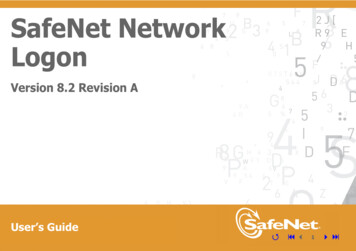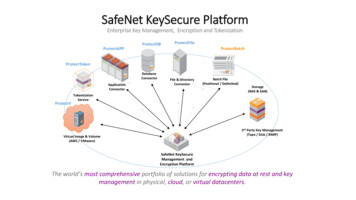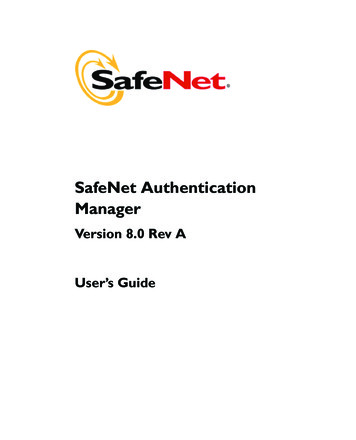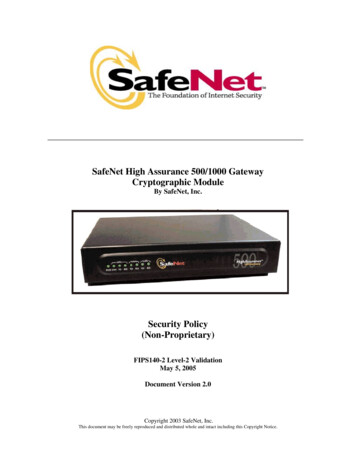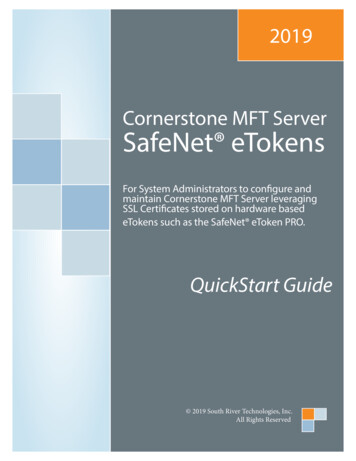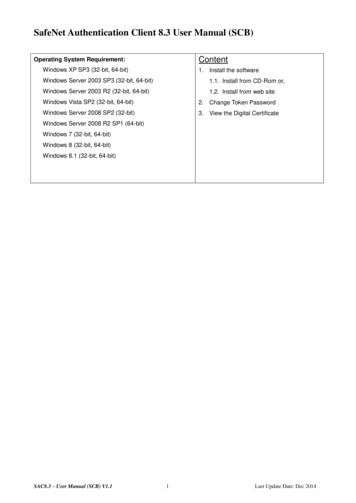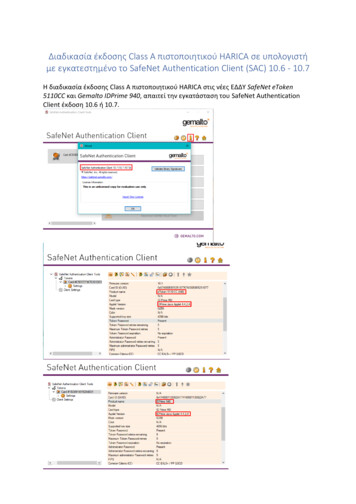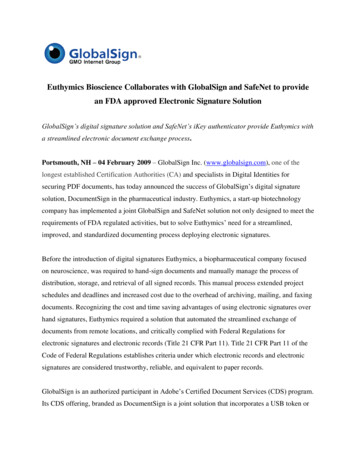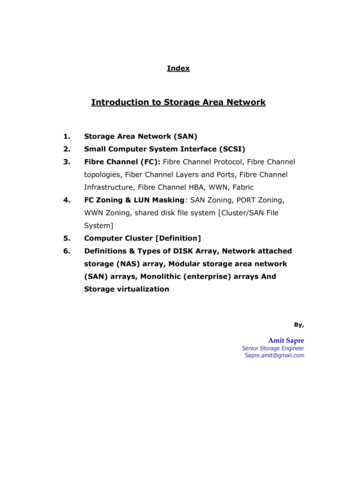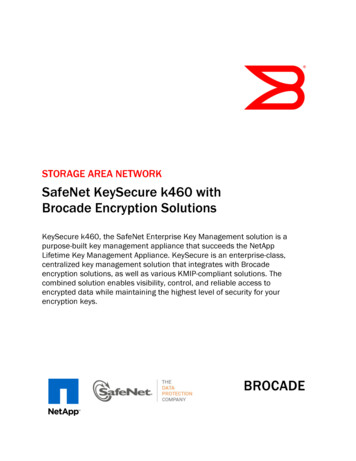
Transcription
STORAGE AREA NETWORKSafeNet KeySecure k460 withBrocade Encryption SolutionsKeySecure k460, the SafeNet Enterprise Key Management solution is apurpose-built key management appliance that succeeds the NetAppLifetime Key Management Appliance. KeySecure is an enterprise-class,centralized key management solution that integrates with Brocadeencryption solutions, as well as various KMIP-compliant solutions. Thecombined solution enables visibility, control, and reliable access toencrypted data while maintaining the highest level of security for yourencryption keys.
STORAGE AREA NETWORKTECHNICAL BRIEFCONTENTSIntroduction.3Overview.3Keys and Key Management.4Enterprise Security Features.7Role-Based Access Control .7Auditing, Logging, and Alerting .7Verification of Key Integrity .7Integration Scenarios.8Mirrored Data Facilities.8Remote Tape.9NetApp DataFort Upgrade.10Summary.12SafeNet KeySecure k460 with Brocade Encryption Solutions2 of 13
STORAGE AREA NETWORKTECHNICAL BRIEFINTRODUCTIONBrocade , NetApp , and SafeNet have combined forces to provide a robust and scalable encryption solution with anenterprise-class key management solution—SafeNet KeySecure . KeySecure offers a hardened OS, a tamperresistant chassis, multifactor authentication, and dual-person control of critical operations to ensure completesecurity of encryption keys. This paper explores how the Brocade encryption solutions leverage many of the featuresof KeySecure to deliver the most secure Fibre Channel (FC) encryption solution on the market.NOTE: The term “Brocade encryption solution” is used in this paper to refer to both the Brocade Encryption Switchand the Brocade FS8-18 Encryption Blade.A unique aspect of the Brocade-NetApp-SafeNet data-at-rest encryption solution is the centralized key lifecyclemanagement and key sharing capabilities of KeySecure. For regulatory compliance and confidential data sharing,encrypted data and data encryption keys are often required to be transported between sites. The trusted relationshipbetween Brocade encryption solutions and SafeNet KeySecure enable simple-yet-secure key lifecycle managementbetween multiple geographically dispersed sites. KeySecure and its trusted relationship with Brocade encryptionsolutions enables secure and automated key sharing and consistent policy enforcement between multiple sites,providing transparent access to encrypted data at all times by authorized users.This paper focuses on key management with SafeNet KeySecure and assumes a basic understanding of the Brocadedata-at-rest encryption solutions. White papers that discuss the basics of encryption and Brocade encryptionsolutions can be found at www.brocade.com.OVERVIEWA quick overview of the equipment provided in the solution is helpful in understanding the context of this discussion.Brocade recommends deploying encryption with redundant encryption devices and redundant SafeNet KeySecureappliances. As shown in Figure 1, the components of this scenario include the following: An initiator to read and write the data A target to store the data An FC fabric, which in this example consists of two Brocade Encryption Switches Encryption devices to encrypt and decrypt the data Redundant KeySecure appliances to centrally manage and share the Data Encryption Keys (DEKs) from Brocadeand other heterogeneous encryption devices, including Key Management Interoperability Protocol (KMIP)compliant devices. Brocade Network Advisor to manage the fabric and encryption A management Local Area Network (LAN) to link the management station and fabric devices (including theencryption devices and other equipment) A separate cluster LAN of Gigabit Ethernet (GbE) links between the encryption devices for exchanging DEKs (notshown in Figure 1)KeySecure securely connects and communicates with Brocade encryption solutions, NetApp DataFort appliances,NetApp LKM appliances, and NetApp NSE (NetApp Storage Encryption) appliances, as well as heterogeneousencryption devices. KeySecure manages storage security device keys and settings, including exchanging DEKsbetween SafeNet KeySecure, Brocade encryption solutions, and other third-party encryption platforms. The Brocadeencryption solution generates the DEKs and wraps (encrypts) them before sending them to KeySecure within aTransport Layer Security (TLS) session. The SafeNet KeySecure appliance automatically backs up and synchronizeskey lifecycle, policy, and configuration information between clustered KeySecure appliances. KeySecure managesthe DEKs and performs other tasks, which are discussed in the next section.Figure 1 shows how the DEKs are exchanged between devices in the encryption solution. The DEK is first generatedby the encryption device and can be sent to the primary KeySecure appliance. The encryption device thensynchronizes DEKs with the other encryption devices in the fabric through the Cluster LAN. The KeySecureSafeNet KeySecure k460 with Brocade Encryption Solutions3 of 13
STORAGE AREA NETWORKTECHNICAL BRIEFappliances also synchronize keys and policies between clustered appliances to ensure access to keys if oneappliance is unavailable. These redundant key exchanges are crucial to ensuring that the data can be encrypted ordecrypted without creating a single point of failure.Figure 1. Components of the Brocade-SafeNet solutionKEYS AND KEY MANAGEMENTOne of the strengths of the solution is that data encryption keys are secured on a Federal Information ProcessingStandard (FIPS) 140-2 Level 3 hardware security module within KeySecure. KeySecure uses a SafeNet Luna PCI-eCryptographic Module to secure all encryption keys. All transportation of the keys between clients and SafeNetKeySecure occurs on a secure channel. To ensure security of the keys during movement, a hierarchical key modelwith crypto trusted links is used. Hierarchical key sharing groups enables clients to belong to more than one group.Through this hierarchy of keys, higher-level keys are always used to wrap lower-level keys before leaving the FIPSsecurity boundary.As mentioned earlier, the unique trust relationship between SafeNet and Brocade allows establishment of asymmetric 256-bit strength link key to facilitate movement of all encryption keys. In order to maintain the keystrength in the entire system, whenever the key is in transit, it is protected using this 256-bit strength link key. Thedecision to use symmetric keys for this solution was important to ensure consistent key strength throughout thesolution. Use of a different key protection mechanism, such as asymmetric keys, could significantly lower the overallkey strength of the system. Asymmetric keys must be significantly larger in order to achieve the same bit strength.Table 1 compares the relative key strength of symmetric and asymmetric keys.SafeNet KeySecure k460 with Brocade Encryption Solutions4 of 13
STORAGE AREA NETWORKTECHNICAL BRIEFTable 1. Comparative Key Strengths of Symmetric vs. Asymmetric KeysSymmetric Key Size (bits)Asymmetric Key Size (bits)80102411220481283072192768025615360KeySecure and the Brocade encryption solution establish a 256-bit strength link key after digital certificates areverified. The link key is used to encrypt DEKs before they are transported. To be compliant with FIPS 140-2 Level 3,both the Brocade encryption device and SafeNet KeySecure have a security boundary that defines where DEKs areencrypted and stored. Before being transported outside the encryption boundary, DEKs are always encrypted, orwrapped, with the link key.1.The following numbered items correspond to the circled numbers in Figure 2, which shows the process ofexchanging keys.2.A trusted relationship is created through a secure exchange between the Brocade encryption solution andSafeNet KeySecure. The trusted link generates a symmetric link key (shown in orange), which is stored in eachdevice and is used to wrap the DEK for secure transport.3.The Brocade encryption device creates a new DEK in cleartext (shown in red) within its security boundary.4.The DEK is encrypted (wrapped) with the link key to create a wrapped DEK (shown in blue) before it leaves theencryption boundary.5.The wrapped key is sent to SafeNet KeySecure in the Secure Sockets Layer (SSL) session with a key strength of256 bits. (Note that the DEK was already wrapped with the 256-bit strength key, so the SSL session key doesnot weaken the key strength of the system.)6.After the wrapped key arrives inside the security boundary of KeySecure, KeySecure uses its symmetric link keyto unwrap the DEK to discover DEK in cleartext.7.KeySecure then uses the KeySecure domain key (shown in gray) to encrypt the DEK for storage outside thesecurity boundary in its redundant disk drives.Figure 2. Key exchange between a Brocade encryption device and SafeNet KeySecureSafeNet KeySecure k460 with Brocade Encryption Solutions5 of 13
STORAGE AREA NETWORKTECHNICAL BRIEFOne of the principal benefits of the trusted relationship between SafeNet KeySecure and the Brocade encryptionsolution is the ability to share keys within Key Sharing Groups (KSGs). The ability to create a trusted relationship withanother appliance is the foundation of the KSG feature. KSGs are key movement policies that govern whichencryption device can gain access to which keys. The KSG rules are simple, but the implementation enablessophisticated deployments.The three rules of Key Sharing Groups are as follows:1.Encryption devices within the same KSG can share keys.2.Encryption devices in a parent KSG can access keys in their child KSG.3.Encryption devices in a child KSG cannot access keys from their parent KSG.Consider the example deployment shown in Figure 3. Each device represents a Key Sharing Group to which anencryption device could belong. All devices in the U.S. KSG can access keys from devices in the U.S., New York, orSan Francisco (SF). However, New York and SF devices can access only keys in their respective KSGs. In this way, acustomer could compartmentalize groups of encrypting devices and restrict their key access depending on whichKSG they are assigned to.Figure 3. Key Sharing Group exampleAssignment to a particular KSG is not a permanent state. The KeySecure Administrator can move both keys andencryption devices from one KSG to another to facilitate access. Table 2 illustrates results from a typical query forkeys in the KeySecure appliance. A single key or group of keys can be easily identified by many parameters, includingtheir KSG membership or tape label. In this example, encrypted tape A0004 was written from an encryption device in/US/NewYork. If the tape needs to be restored in London, there are two ways to give the devices in /EU/Londonaccess to the encryption key: First, an encryption device can be moved from the existing /EU/London KSG into the /US/NewYork KSG. Thisenables the London encryption device to access all keys in the /US/NewYork KSG. Second, the administrator can simply select the individual encryption key—identified by the tape label A0004—and move that key into the /EU/London KSG. This limits access to only the key that is needed.Table 2. Sample Output Table from SafeNet KeySecure, Showing Encryption Key IDs and KSGsKey IDKey Sharing GroupPool LabelTape IncrementalA0004NOTE: The Key IDs shown are simply pointers, and not the actual encryption keys.SafeNet KeySecure k460 with Brocade Encryption Solutions6 of 13
STORAGE AREA NETWORKTECHNICAL BRIEFThe previous example illustrates how simple but powerful the concept of Key Sharing Groups is, to allow easy, yetsecure movement of encryption keys across geographic boundaries. Keys can be moved in bulk by putting encryptiondevices in the same KSG, but KeySecure also permits granular key movement—down to the level of individualencrypted tape.SafeNet KeySecure provides not only enterprise-level key distribution, but it also ensures availability of the keys withmultiple layers of redundancy. KeySecure has two hot-swappable power supplies, as well as two hot-swappableSmall Computer Systems Interface (SCSI) disks configured in RAID1. Even if a single disk drive fails, access is stillenabled to all encryption keys from the local KeySecure appliance.Availability across systems is possible through trustee links with up to 16 other SafeNet KeySecure appliances. Byforming trustee relationships with other KeySecure appliances, encryption keys are automatically synchronizedbetween all peers; thus, they are made available in case of the failure of an entire appliance. Furthermore,configuration databases (configdbs) from each SafeNet KeySecure appliance are backed up to other KeySecureappliances to facilitate recovery of any failed appliance.Each Brocade encryption solution has the capability to send and request encryption keys to and frommultiple KeySecure appliances. Newly generated encryption keys are automatically sent to all registeredKeySecure appliances to ensure availability of the keys. The administrator can also manually initiate abackup of the keys and their configuration database. In the event of a failure on the Brocade encryptionsolution, keys can be quickly and easily recovered by recreating the trustee relationships between areplacement Brocade encryption solution and any SafeNet KeySecure appliance on the network.ENTERPRISE SECURITY FEATURESTo complement the enterprise level security, key movement, and availability, KeySecure also offers featuresnecessary for a device of its class, as described in this section: Granular role-based access control Auditing, logging, and alerting Verification of key integrityRole-Based Access ControlCustomers who choose encryption as their solution to protecting data-at-rest are also often looking for features thatallow them to compartmentalize administration functions to ensure role separation. With SafeNet KeySecure,granular role-based access controls are a critical step in the right direction. KeySecure supports multiple roles foradministrators, such as Full Admin, Account Admin, Key Admin, Security Admin, Backup Admin, Machine Admin, andRead-Only Admin. Each administrator role is allowed to perform only a subset of duties, to distribute responsibilityacross multiple individuals. For example, the Key Admin can assign appliances to Key Sharing Groups and movekeys between KSGs, while the Account Admin can only create, manage, and delete administrator accounts.KeySecure is also flexible enough to create custom administrator roles by combining multiple roles into anadministrator role that suits a company’s needs.Auditing, Logging, and AlertingAuditing and compliance are essential considerations to ensuring security of data-at-rest. SafeNet KeySecureprovides cryptographic assurances that the log messages are authentic. All keys are securely managed, keyownership is clearly defined, and key lifecycle management and modifications are recorded and securely stored,providing a non-repudiative audit trail of key state changes. Administrators and security personnel are informed ifattempts to breach protected keys occur.Verification of Key IntegrityAs discussed earlier, the SafeNet KeySecure appliance provides a hardened cryptographic boundary to ensure thatencryption keys are always physically secure. KeySecure also wraps DEKs during transport, using the same bitSafeNet KeySecure k460 with Brocade Encryption Solutions7 of 13
STORAGE AREA NETWORKTECHNICAL BRIEFstrength (256-bit) as the DEK itself, to ensure security of the key as it moves through the network. KeySecureprovides a further check on all DEKs by digitally signing each DEK as it is stored. KeySecure accomplishes this byusing a unique signing key and applying the HMAC-SHA-256 function on each key to create a unique key signaturefor each DEK. When an encrypting device requests a DEK from KeySecure, this key signature is verified for integritybefore the key is made available for encryption or decryption services, as shown in Figure 4. This additionalsafeguard on the key ensures that the key has not been tampered with, which has the potential to weaken thestrength of the data the key was designed to protect.Figure 4. Key signing for integrityINTEGRATION SCENARIOSSafeNet key management solutions have provided robust encryption and key management for years, and theBrocade encryption solutions are designed as an upgrade path to increase port density and ease scaling to higherthroughputs. Three scenarios are described in this section: Mirrored data facilities Remote tape NetApp DataFort upgradeMirrored Data FacilitiesFigure 5 investigates disk mirroring using NetApp SnapMirrror technology between sites. Site 1 is the primary site,where the data and DEK are generated and mirrored to Site 2. The Brocade encryption solutions synchronize DEKsover the cluster LAN, while SafeNet KeySecure synchronizes key replication and movement over a separate IPnetwork that may be on a different virtual LAN (VLAN). Hosts at either site must be configured for encryption toaccess the storage. The DEK exchange between SafeNet KeySecure Appliance 4 and Brocade Encryption Device 2 isnot used, unless the cluster LAN is down and new DEKs are created at Site 1. With multiple access routes to theDEKs, the Brocade encryption solutions ensure that the data is highly available.SafeNet KeySecure k460 with Brocade Encryption Solutions8 of 13
STORAGE AREA NETWORKTECHNICAL BRIEFFigure 5. Data mirroring, encryption, and key management spanning two sitesRemote TapeAnother example of the tight integration between Brocade, NetApp, and SafeNet shows how keys are interoperablein tape environments. In this scenario, a company has been backing up tapes at multiple remote sites and shippingthe tapes back to headquarters. To decrypt the tapes at headquarters, keys are transparently and securelyexchanged between the SafeNet KeySecure appliances. In the scenario, the most difficult part of the restore istransporting the encrypted tapes between the data centers in a delivery truck. Since the tapes are encrypted, thecompany can feel secure in sending them via any overnight carrier.SafeNet KeySecure k460 with Brocade Encryption Solutions9 of 13
STORAGE AREA NETWORKTECHNICAL BRIEFFigure 6. Key exchange between remote sitesAfter mergers and acquisitions, large enterprises often have a variety of systems that need to be integrated. Thisscenario shows how keys can be exchanged for a variety of applications. A user needs only an Internet connection toexchange the keys, so that the tapes can then be delivered to a central location for decoding. If a company needs toprovide records stored on tape to auditors, the tape and keys can be provided to the auditor for decryption.NetApp DataFort UpgradeThis final scenario shows an initial deployment with a pair of NetApp DataFort FC-Series encryption appliancesattached to the fabric and a 4-port storage array. The customer has gone through significant expansion of data andis upgrading its storage with a 32-port storage array.Figure 8 shows how the same key management infrastructure can be used with Brocade encryption solutions andNetApp DataFort appliances, which initially encrypt eight of the array ports. The SafeNet KeySecure applianceprovides a key management infrastructure that allows integration of both vendor products to provide encryptionservices for an expanding storage environment. In addition, the upgrade path is backward and forward compatible,to provide a continued Return on Investment (ROI).SafeNet KeySecure k460 with Brocade Encryption Solutions10 of 13
STORAGE AREA NETWORKTECHNICAL BRIEFFigure 7. Initial deploymentFigure 8. Upgraded deploymentSafeNet KeySecure k460 with Brocade Encryption Solutions11 of 13
STORAGE AREA NETWORKTECHNICAL BRIEFSUMMARYThe scenarios in this paper illustrate how the Brocade encryption solutions and SafeNet KeySecure work together toprovide reliable and trusted encryption and key management solutions. The basic configuration with redundantSafeNet KeySecure appliances and Brocade encryption solutions shows how the joint solution ensures highavailability to encrypted data, while securing, sharing, and centralizing all of the encryption keys into a hardenedhardware appliance. Brocade, NetApp, and SafeNet have also designed solutions so that existing systems can easilybe upgraded to achieve high port density. While using the same SafeNet KeySecure appliances, an administrator canuse the latest hardware running at 8 Gbps per port and encryption processing power that starts at 48 Gbps andscales to 96 Gbps on the Brocade encryption solutions. Combining power and ease of use, these encryptionsolutions also deliver compliance to the most stringent regulations.Together, NetApp, SafeNet, and Brocade have combined their expertise in security and storage networks,respectively, to provide the leading Fibre Channel data-at-rest encryption solution. With FIPS 140-2 Level 3validation, customers are assured the highest level of security. NetApp, SafeNet, and Brocade also provideconsulting services to make it easier to plan and deploy the solution. Given the years of experience in storagenetworking and encryption from NetApp, SafeNet, and Brocade, customers have peace of mind knowing that theirdata is secure and protected with the latest encryption technology.SafeNet KeySecure k460 with Brocade Encryption Solutions12 of 13
STORAGE AREA NETWORKTECHNICAL BRIEF 2012 Brocade Communications Systems, Inc. All Rights Reserved. 07/12 GA-TB-448-00DX, Brocade, Brocade Assurance, Brocade One, the B-wing symbol, DCX, Fabric OS, ICX, MLX, SAN Health, VCS, and VDX are registeredtrademarks, and AnyIO, HyperEdge, MyBrocade, NET Health, OpenScript, and The Effortless Network are trademarks of BrocadeCommunications Systems, Inc., in the United States and/or in other countries. Other brands, products, or service names mentioned maybe trademarks of their respective owners.Notice: This document is for informational purposes only and does not set forth any warranty, expressed or implied, concerning anyequipment, equipment feature, or service offered or to be offered by Brocade. Brocade reserves the right to make changes to thisdocument at any time, without notice, and assumes no responsibility for its use. This informational document describes features that maynot be currently available. Contact a Brocade sales office for information on feature and product availability. Export of technical datacontained in this document may require an export license from the United States government. 2012 SafeNet, Inc. All rights reserved. SafeNet and SafeNet logo are registered trademarks of SafeNet.The information provided in this document summarizes the performance and other technical characteristics of SafeNet products. SafeNetmakes all reasonable efforts to verify this information; however, the information provided in this document is only to educate you about theproducts and may be changed or updated at any time by SafeNet. SafeNet makes no explicit or implied claims to the continuing validity ofthis information, which is provided “as is.”All other product names are trademarks of their respective owners.Contact Us: For all office locations and contact information, please visit www.safenet-inc.comFollow Us: www.safenet-inc.com/connected 2012 NetApp. All rights reserved.Specifications are subject to change without notice. NetApp, the NetApp logo, Go further, faster, SnapMirror, Lifetime Key Management,and DataFort are trademarks or registered trademarks of NetApp, Inc. in the United States and/or other countries. All other brands orproducts are trademarks or registered trademarks of their respective holders and should be treated as such.SafeNet KeySecure k460 with Brocade Encryption Solutions13 of 13
Brocade Network Advisor to manage the fabric and encryption A management Local Area Network (LAN) to link the management station and fabric devices (including the encryption devices and other equipment) A separate cluster LAN of Gigabit Ethernet (GbE) links between the encryption devices for exchanging DEKs (not shown in Figure 1)
